
View over Stuttgart from the north with the iconic television tower in the background. It was the first telecommunications tower in the world constructed from reinforced concrete, and it is the prototype for many such towers worldwide. (1191k)
From the Stuttgart entry in Wikipedia:
Stuttgart is the capital and largest city of the German state of Baden-Württemberg. It is located on the Neckar river in a fertile valley known as the Stuttgarter Kessel (Stuttgart Cauldron) and lies an hour from the Swabian Jura and the Black Forest. Stuttgart has a population of 635,000 (2018), making it the sixth largest city in Germany. 2.8 million people live in the city's administrative region (2019) and 5.3 million people in its metropolitan area (2019), making it the fourth largest metropolitan area in Germany. The city and metropolitan area are consistently ranked among the top 20 European metropolitan areas by GDP; Mercer listed Stuttgart as 21st on its 2015 list of cities by quality of living; innovation agency 2thinknow ranked the city 24th globally out of 442 cities in its Innovation Cities Index; and the Globalization and World Cities Research Network ranked the city as a Beta-status global city in their 2020 survey. Stuttgart was one of the host cities for the official tournaments of the 1974 and 2006 FIFA World Cups.
Stuttgart is unusual in the scheme of German cities. It is spread across a variety of hills (some of them covered in vineyards), valleys (especially around the Neckar river and the Stuttgart basin) and parks. The city is known as the "cradle of the automobile". As such, it is home to famous automobile museums like the Mercedes-Benz Museum and Porsche Museum, as well as numerous auto-enthusiast magazines, which contributes to Stuttgart's status as Germany's "Autohauptstadt" ("car capital city"). The city's tourism slogan is "Stuttgart offers more". Under current plans to improve transport links to the international infrastructure (as part of the Stuttgart 21 project), Stuttgart unveiled a new city logo and slogan in March 2008, describing itself as "Das neue Herz Europas" ("The new Heart of Europe"). For business, it describes itself as "Where business meets the future". In July 2010, the city unveiled a new logo, designed to entice more business people to stay in the city and enjoy breaks in the area.
Since the seventh millennium BCE, the Stuttgart area has been an important agricultural area and has been host to a number of cultures seeking to utilize the rich soil of the Neckar valley. The Roman Empire conquered the area in CE 83 and built a massive castrum near Bad Cannstatt, making it the most important regional center for several centuries. Stuttgart's roots were truly laid in the tenth century with its founding by Liudolf, Duke of Swabia, as a stud farm for his warhorses. Initially overshadowed by nearby Bad Cannstatt, the town grew steadily and was granted a charter in 1320. The fortunes of Stuttgart turned with those of the House of Württemberg, and they made it the capital of their county, duchy, and kingdom from the 15th century to 1918. Stuttgart prospered despite setbacks in the Thirty Years' War and devastating air raids by the Allies on the city and its automobile production during World War II. However, by 1952, the city had bounced back and became the major economic, industrial, tourism and publishing center it is today.
All pictures are © Dr. Günther Eichhorn, unless otherwise noted.







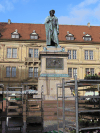




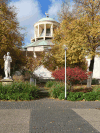




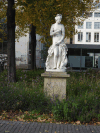

From the Solitude Palace entry in Wikipedia:
Solitude Palace (German: Schloss Solitude) is a Rococo palace and hunting retreat commissioned by Charles Eugene, Duke of Württemberg. It was designed by Johann Friedrich Weyhing and Philippe de La Guêpière, and constructed from 1764 to 1769. It is located on an elongated ridge between the towns of Leonberg, Gerlingen and Stuttgart in Baden-Württemberg.

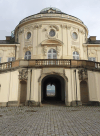


From the Bismarck Tower entry in Wikipedia:
Bismarck Towers are a unique German monument genre, to honor the ex-chancellor Otto von Bismarck. Approximately 250 of these towers were built between the years 1869 and 1934, in various styles, on four continents (Australia, South America, Africa and Europe), of which about 175 remain. Architects of these towers include Wilhelm Kreis and Bruno Schmitz.
The twenty-meter high Bismarck tower in Stuttgart stands one kilometer south-west of the exhibition halls. It was built on the Gaehkopf, the highest point in northern Stuttgart, giving good views of Stuttgart itself and in all directions. It was one of many towers built to commemorate Otto von Bismarck. The building of the tower was begun in 1902 by the students of the technical university in Stuttgart. The Stuttgart Bismarck tower was opened on 16 July 1904. In 2004, for its 100th anniversary, it was comprehensively renovated.
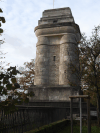
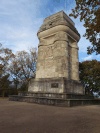
From the Stiftskirche, Stuttgart entry in Wikipedia:
The Stiftskirche (Collegiate Church) is an inner-city church in Stuttgart, the capital of Baden-Württemberg, Germany. It is the main church of the Evangelical-Lutheran Church in Württemberg (Evangelische Landeskirche in Württemberg) as well as the parish church of the evangelical (Lutheran) inner-city church district of Stuttgart.
Recent research found structures of a small Romanesque church dating to the 10th and 11th centuries within the outline of today's church.
In 1240, a stately three-naved church with two towers was built in the Romanic style, apparently by the Counts of Württemberg who from around that time were residing in the nearby Old Castle. The remains of Ulrich I, Count of Württemberg and his second wife, Countess of Württemberg, Agnes von Schlesien-Liegnitz (both died in 1265) rest in a double tomb in the south tower chapel that dates to the late 13th century.
When Stuttgart became the new residence of the rulers of Württemberg, they added a new Gothic chancel between 1321 to 1347. Ulrich V added a Late Gothic nave in the second half of the 15th century.
In 1500, a coloured, later (from the 19th century) golden pulpit was added.
With the adoption of the Lutheran Protestant Reformation in Württemberg in 1534, all pictures and altars were removed from the naves, pewage and a gallery were added. The tombstones were moved to the interior of the church.
The Lutheran reformer Johannes Brenz, the main Protestant Reformer of Württemberg, was buried under the chancel after his death in 1570.
From 1574, small statues of all the Counts of Württemberg (i.e. since Ulrich I) were added at the North wall of the chancel.
In 1608, a new grave crypt or burial vault was added. All of the Württemberg rulers until 1677 were buried there. Catherine Pavlovna of Russia, Queen of Württemberg from 1816 until 1819, was buried here from 1819 to 1824, before her remains were brought to a mausoleum on the Württemberg mountain.
In 1826, the roof of the chancel was renovated, as was most of the interior of the church in the 1840s.
Near the end of World War II, the church was heavily damaged by the bombing raids on Stuttgart in 1944. The church was rebuilt in the 1950s, however, the interior was rebuilt in a modern style.

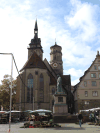
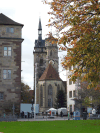
The Anniversary Column is a monument that was erected on the Schloßplatz in Stuttgart from 1841 to 1846 to mark the 25th anniversary of the government and the 60th birthday of King Wilhelm I of Württemberg. The column consists of a 30 meter high granite shaft, the 5 meter high statue of the Roman goddess Concordia, four reliefs with historical scenes and four allegorical figures at the corners of the column base.

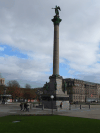



From the Old Castle (Stuttgart) entry in Wikipedia:
The Old Palace (German: Altes Schloss) is a former castle located on the Schillerplatz in Stuttgart, Germany. The palace, originally a water castle dating back to the 10th century, was the residence of the Counts and later some Dukes of Württemberg and today is the home of the Landesmuseum Württemberg. The palace church (German: Schlosskirche) still functions as a place of worship.




From the New Palace, Stuttgart entry in Wikipedia:
The New Palace (German: Neues Schloss) is an 18th-century Baroque palace in Stuttgart and is one of the last large city palaces built in Southern Germany. The palace is located on the Schlossplatz in front of the Jubiläumssäule column and Königsbau. Public tours of the building are only permitted by special arrangement, as the building contains some government offices. Once a historic residence of the Kings of Württemberg, the New Palace derives its name from its commissioning by Duke Carl Eugen of Württemberg to replace the Old Castle in the early years of his reign. Originally, Charles commissioned Nikolaus Friedrich Thouret, but architects Leopoldo Retti, Philippe de La Guêpière, Reinhard Heinrich Ferdinand Fischer would contribute to the design, history, and construction of the palace.
The palace was heavily bombed in World War II, leaving only a shell. It was finally agreed to rebuild it in 1957.

This page contains 38 pictures

Main page for Deutschland (Germany)
Page last updated on Tue Jan 10 16:12:17 2023 (Mountain Standard Time)
Stuttgart on gei.guenther-eichhorn.com